tire size JEEP CHEROKEE 2020 Owner handbook (in English)
[x] Cancel search | Manufacturer: JEEP, Model Year: 2020, Model line: CHEROKEE, Model: JEEP CHEROKEE 2020Pages: 332, PDF Size: 8.87 MB
Page 247 of 332
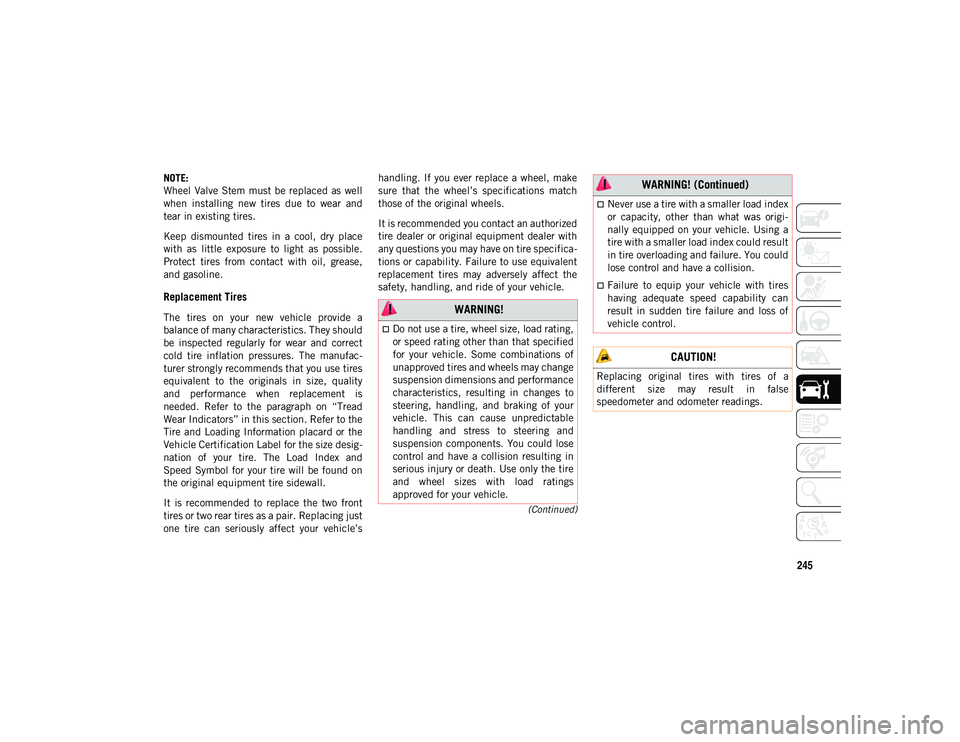
245
(Continued)
NOTE:
Wheel Valve Stem must be replaced as well
when installing new tires due to wear and
tear in existing tires.
Keep dismounted tires in a cool, dry place
with as little exposure to light as possible.
Protect tires from contact with oil, grease,
and gasoline.
Replacement Tires
The tires on your new vehicle provide a
balance of many characteristics. They should
be inspected regularly for wear and correct
cold tire inflation pressures. The manufac-
turer strongly recommends that you use tires
equivalent to the originals in size, quality
and performance when replacement is
needed. Refer to the paragraph on “Tread
Wear Indicators” in this section. Refer to the
Tire and Loading Information placard or the
Vehicle Certification Label for the size desig -
nation of your tire. The Load Index and
Speed Symbol for your tire will be found on
the original equipment tire sidewall.
It is recommended to replace the two front
tires or two rear tires as a pair. Replacing just
one tire can seriously affect your vehicle’s handling. If you ever replace a wheel, make
sure that the wheel’s specifications match
those of the original wheels.
It is recommended you contact an authorized
tire dealer or original equipment dealer with
any questions you may have on tire specifica
-
tions or capability. Failure to use equivalent
replacement tires may adversely affect the
safety, handling, and ride of your vehicle. WARNING!
Do not use a tire, wheel size, load rating,
or speed rating other than that specified
for your vehicle. Some combinations of
unapproved tires and wheels may change
suspension dimensions and performance
characteristics, resulting in changes to
steering, handling, and braking of your
vehicle. This can cause unpredictable
handling and stress to steering and
suspension components. You could lose
control and have a collision resulting in
serious injury or death. Use only the tire
and wheel sizes with load ratings
approved for your vehicle.
Never use a tire with a smaller load index
or capacity, other than what was origi -
nally equipped on your vehicle. Using a
tire with a smaller load index could result
in tire overloading and failure. You could
lose control and have a collision.
Failure to equip your vehicle with tires
having adequate speed capability can
result in sudden tire failure and loss of
vehicle control.
CAUTION!
Replacing original tires with tires of a
different size may result in false
speedometer and odometer readings.
WARNING! (Continued)
2020_JEEP_CHEROKEE_UG_RHD_UK.book Page 245
Page 248 of 332
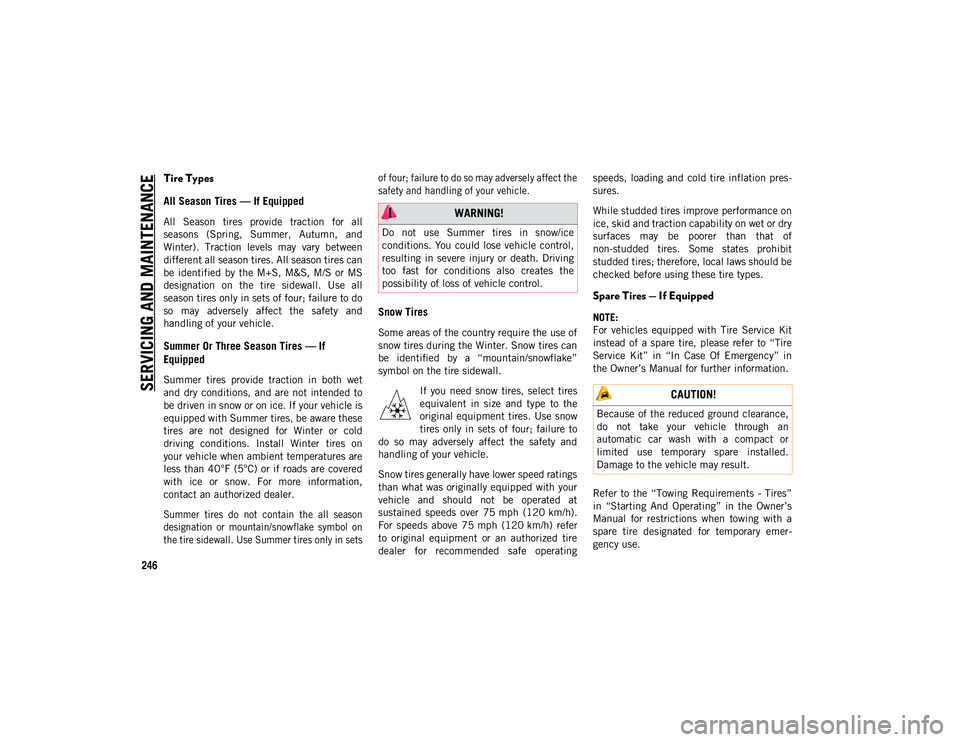
SERVICING AND MAINTENAN
CE
246
Tire Types
All Season Tires — If Equipped
All Season tires provide traction for all
seasons (Spring, Summer, Autumn, and
Winter). Traction levels may vary between
different all season tires. All season tires can
be identified by the M+S, M&S, M/S or MS
designation on the tire sidewall. Use all
season tires only in sets of four; failure to do
so may adversely affect the safety and
handling of your vehicle.
Summer Or Three Season Tires — If
Equipped
Summer tires provide traction in both wet
and dry conditions, and are not intended to
be driven in snow or on ice. If your vehicle is
equipped with Summer tires, be aware these
tires are not designed for Winter or cold
driving conditions. Install Winter tires on
your vehicle when ambient temperatures are
less than 40°F (5°C) or if roads are covered
with ice or snow. For more information,
contact an authorized dealer.
Summer tires do not contain the all season
designation or mountain/snowflake symbol on
the tire sidewall. Use Summer tires only in setsof four; failure to do so may adversely affect the
safety and handling of your vehicle.
Snow Tires
Some areas of the country require the use of
snow tires during the Winter. Snow tires can
be identified by a “mountain/snowflake”
symbol on the tire sidewall.
If you need snow tires, select tires
equivalent in size and type to the
original equipment tires. Use snow
tires only in sets of four; failure to
do so may adversely affect the safety and
handling of your vehicle.
Snow tires generally have lower speed ratings
than what was originally equipped with your
vehicle and should not be operated at
sustained speeds over 75 mph (120 km/h).
For speeds above 75 mph (120 km/h) refer
to original equipment or an authorized tire
dealer for recommended safe operating speeds, loading and cold tire inflation pres
-
sures.
While studded tires improve performance on
ice, skid and traction capability on wet or dry
surfaces may be poorer than that of
non-studded tires. Some states prohibit
studded tires; therefore, local laws should be
checked before using these tire types.
Spare Tires — If Equipped
NOTE:
For vehicles equipped with Tire Service Kit
instead of a spare tire, please refer to “Tire
Service Kit” in “In Case Of Emergency” in
the Owner’s Manual for further information.
Refer to the “Towing Requirements - Tires”
in “Starting And Operating” in the Owner’s
Manual for restrictions when towing with a
spare tire designated for temporary emer -
gency use.
WARNING!
Do not use Summer tires in snow/ice
conditions. You could lose vehicle control,
resulting in severe injury or death. Driving
too fast for conditions also creates the
possibility of loss of vehicle control.
CAUTION!
Because of the reduced ground clearance,
do not take your vehicle through an
automatic car wash with a compact or
limited use temporary spare installed.
Damage to the vehicle may result.
2020_JEEP_CHEROKEE_UG_RHD_UK.book Page 246
Page 249 of 332
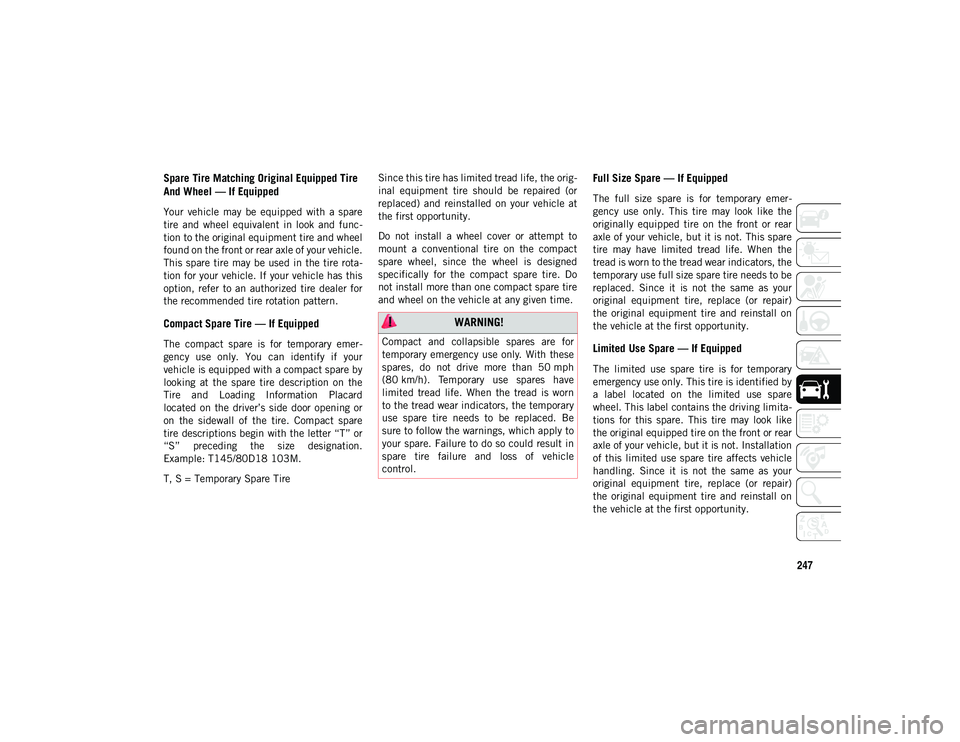
247
Spare Tire Matching Original Equipped Tire
And Wheel — If Equipped
Your vehicle may be equipped with a spare
tire and wheel equivalent in look and func-
tion to the original equipment tire and wheel
found on the front or rear axle of your vehicle.
This spare tire may be used in the tire rota -
tion for your vehicle. If your vehicle has this
option, refer to an authorized tire dealer for
the recommended tire rotation pattern.
Compact Spare Tire — If Equipped
The compact spare is for temporary emer -
gency use only. You can identify if your
vehicle is equipped with a compact spare by
looking at the spare tire description on the
Tire and Loading Information Placard
located on the driver’s side door opening or
on the sidewall of the tire. Compact spare
tire descriptions begin with the letter “T” or
“S” preceding the size designation.
Example: T145/80D18 103M.
T, S = Temporary Spare Tire Since this tire has limited tread life, the orig
-
inal equipment tire should be repaired (or
replaced) and reinstalled on your vehicle at
the first opportunity.
Do not install a wheel cover or attempt to
mount a conventional tire on the compact
spare wheel, since the wheel is designed
specifically for the compact spare tire. Do
not install more than one compact spare tire
and wheel on the vehicle at any given time.
Full Size Spare — If Equipped
The full size spare is for temporary emer -
gency use only. This tire may look like the
originally equipped tire on the front or rear
axle of your vehicle, but it is not. This spare
tire may have limited tread life. When the
tread is worn to the tread wear indicators, the
temporary use full size spare tire needs to be
replaced. Since it is not the same as your
original equipment tire, replace (or repair)
the original equipment tire and reinstall on
the vehicle at the first opportunity.
Limited Use Spare — If Equipped
The limited use spare tire is for temporary
emergency use only. This tire is identified by
a label located on the limited use spare
wheel. This label contains the driving limita -
tions for this spare. This tire may look like
the original equipped tire on the front or rear
axle of your vehicle, but it is not. Installation
of this limited use spare tire affects vehicle
handling. Since it is not the same as your
original equipment tire, replace (or repair)
the original equipment tire and reinstall on
the vehicle at the first opportunity.
WARNING!
Compact and collapsible spares are for
temporary emergency use only. With these
spares, do not drive more than 50 mph
(80 km/h). Temporary use spares have
limited tread life. When the tread is worn
to the tread wear indicators, the temporary
use spare tire needs to be replaced. Be
sure to follow the warnings, which apply to
your spare. Failure to do so could result in
spare tire failure and loss of vehicle
control.
2020_JEEP_CHEROKEE_UG_RHD_UK.book Page 247
Page 251 of 332
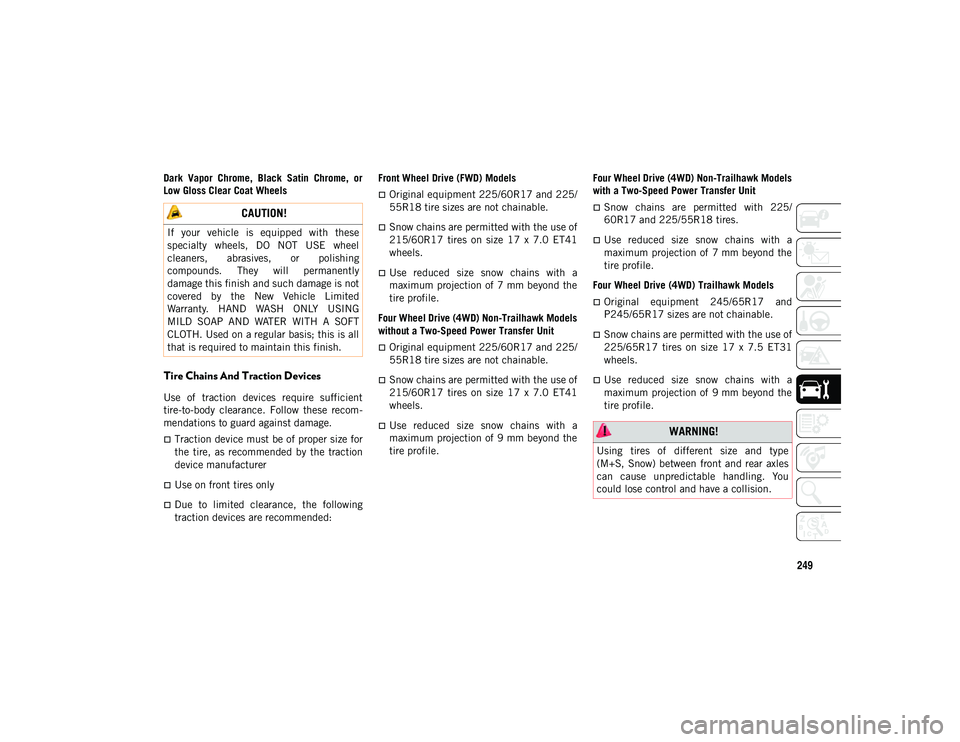
249
Dark Vapor Chrome, Black Satin Chrome, or
Low Gloss Clear Coat Wheels
Tire Chains And Traction Devices
Use of traction devices require sufficient
tire-to-body clearance. Follow these recom-
mendations to guard against damage.
Traction device must be of proper size for
the tire, as recommended by the traction
device manufacturer
Use on front tires only
Due to limited clearance, the following
traction devices are recommended: Front Wheel Drive (FWD) Models
Original equipment 225/60R17 and 225/
55R18 tire sizes are not chainable.
Snow chains are permitted with the use of
215/60R17 tires on size 17 x 7.0 ET41
wheels.
Use reduced size snow chains with a
maximum projection of 7 mm beyond the
tire profile.
Four Wheel Drive (4WD) Non-Trailhawk Models
without a Two-Speed Power Transfer Unit
Original equipment 225/60R17 and 225/
55R18 tire sizes are not chainable.
Snow chains are permitted with the use of
215/60R17 tires on size 17 x 7.0 ET41
wheels.
Use reduced size snow chains with a
maximum projection of 9 mm beyond the
tire profile. Four Wheel Drive (4WD) Non-Trailhawk Models
with a Two-Speed Power Transfer Unit
Snow chains are permitted with 225/
60R17 and 225/55R18 tires.
Use reduced size snow chains with a
maximum projection of 7 mm beyond the
tire profile.
Four Wheel Drive (4WD) Trailhawk Models
Original equipment 245/65R17 and
P245/65R17 sizes are not chainable.
Snow chains are permitted with the use of
225/65R17 tires on size 17 x 7.5 ET31
wheels.
Use reduced size snow chains with a
maximum projection of 9 mm beyond the
tire profile.
CAUTION!
If your vehicle is equipped with these
specialty wheels, DO NOT USE wheel
cleaners, abrasives, or polishing
compounds. They will permanently
damage this finish and such damage is not
covered by the New Vehicle Limited
Warranty. HAND WASH ONLY USING
MILD SOAP AND WATER WITH A SOFT
CLOTH. Used on a regular basis; this is all
that is required to maintain this finish.
WARNING!
Using tires of different size and type
(M+S, Snow) between front and rear axles
can cause unpredictable handling. You
could lose control and have a collision.
2020_JEEP_CHEROKEE_UG_RHD_UK.book Page 249
Page 252 of 332
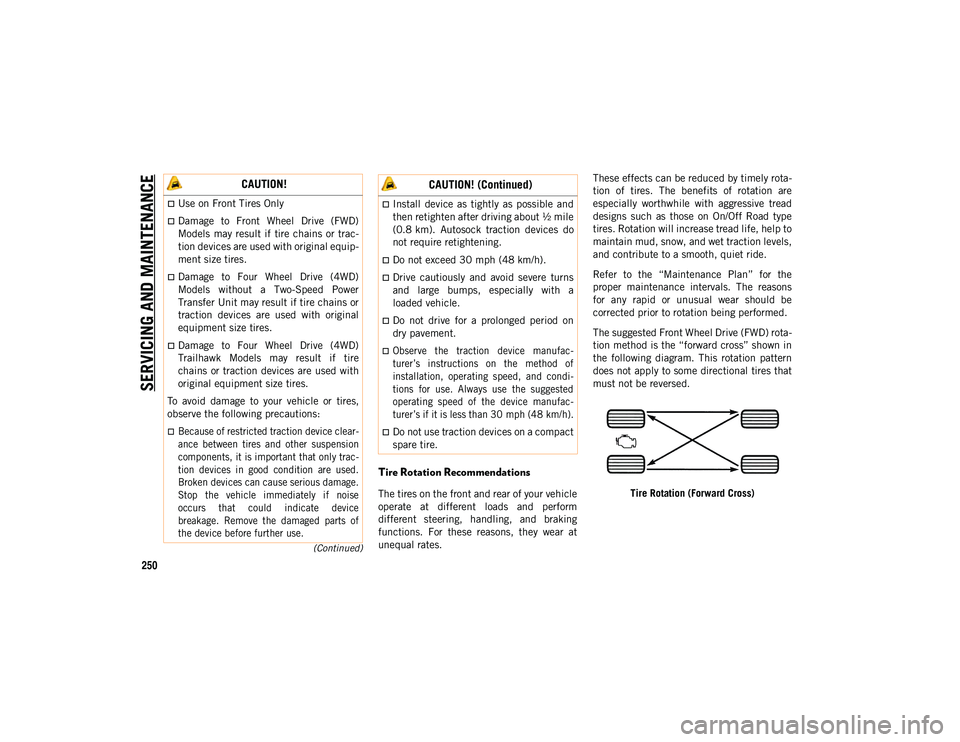
SERVICING AND MAINTENAN
CE
250
(Continued)
Tire Rotation Recommendations
The tires on the front and rear of your vehicle
operate at different loads and perform
different steering, handling, and braking
functions. For these reasons, they wear at
unequal rates.These effects can be reduced by timely rota
-
tion of tires. The benefits of rotation are
especially worthwhile with aggressive tread
designs such as those on On/Off Road type
tires. Rotation will increase tread life, help to
maintain mud, snow, and wet traction levels,
and contribute to a smooth, quiet ride.
Refer to the “Maintenance Plan” for the
proper maintenance intervals. The reasons
for any rapid or unusual wear should be
corrected prior to rotation being performed.
The suggested Front Wheel Drive (FWD) rota -
tion method is the “forward cross” shown in
the following diagram. This rotation pattern
does not apply to some directional tires that
must not be reversed.
Tire Rotation (Forward Cross)
CAUTION!
Use on Front Tires Only
Damage to Front Wheel Drive (FWD)
Models may result if tire chains or trac-
tion devices are used with original equip -
ment size tires.
Damage to Four Wheel Drive (4WD)
Models without a Two-Speed Power
Transfer Unit may result if tire chains or
traction devices are used with original
equipment size tires.
Damage to Four Wheel Drive (4WD)
Trailhawk Models may result if tire
chains or traction devices are used with
original equipment size tires.
To avoid damage to your vehicle or tires,
observe the following precautions:
Because of restricted traction device clear -
ance between tires and other suspension
components, it is important that only trac -
tion devices in good condition are used.
Broken devices can cause serious damage.
Stop the vehicle immediately if noise
occurs that could indicate device
breakage. Remove the damaged parts of
the device before further use.
Install device as tightly as possible and
then retighten after driving about ½ mile
(0.8 km). Autosock traction devices do
not require retightening.
Do not exceed 30 mph (48 km/h).
Drive cautiously and avoid severe turns
and large bumps, especially with a
loaded vehicle.
Do not drive for a prolonged period on
dry pavement.
Observe the traction device manufac -
turer’s instructions on the method of
installation, operating speed, and condi -
tions for use. Always use the suggested
operating speed of the device manufac -
turer’s if it is less than 30 mph (48 km/h).
Do not use traction devices on a compact
spare tire.
CAUTION! (Continued)
2020_JEEP_CHEROKEE_UG_RHD_UK.book Page 250
Page 253 of 332
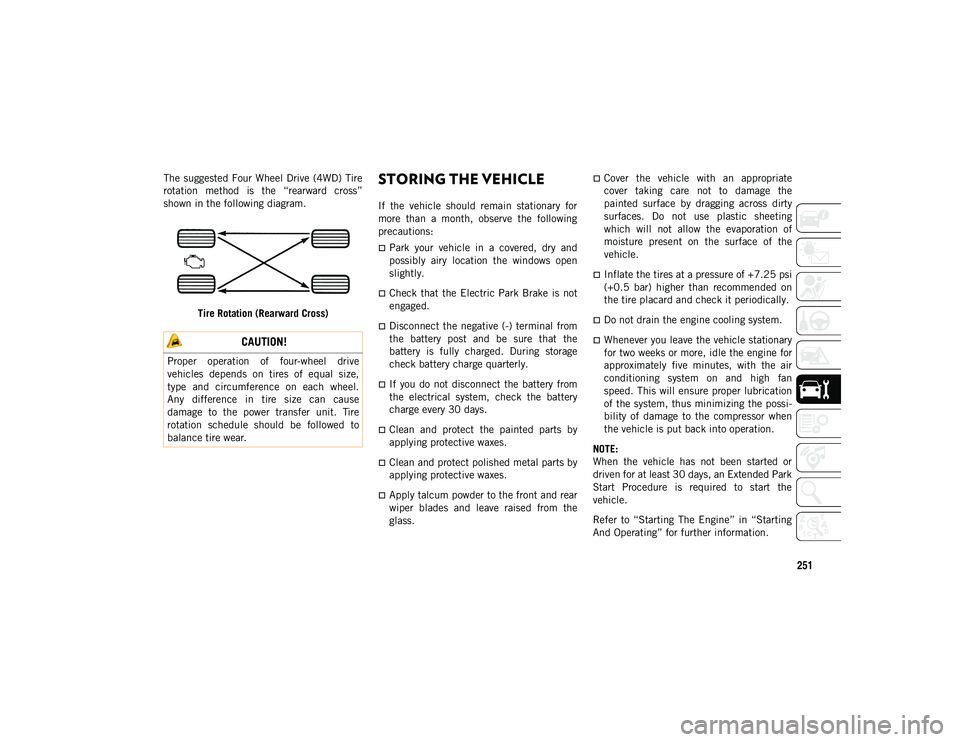
251
The suggested Four Wheel Drive (4WD) Tire
rotation method is the “rearward cross”
shown in the following diagram.Tire Rotation (Rearward Cross)STORING THE VEHICLE
If the vehicle should remain stationary for
more than a month, observe the following
precautions:
Park your vehicle in a covered, dry and
possibly airy location the windows open
slightly.
Check that the Electric Park Brake is not
engaged.
Disconnect the negative (-) terminal from
the battery post and be sure that the
battery is fully charged. During storage
check battery charge quarterly.
If you do not disconnect the battery from
the electrical system, check the battery
charge every 30 days.
Clean and protect the painted parts by
applying protective waxes.
Clean and protect polished metal parts by
applying protective waxes.
Apply talcum powder to the front and rear
wiper blades and leave raised from the
glass.
Cover the vehicle with an appropriate
cover taking care not to damage the
painted surface by dragging across dirty
surfaces. Do not use plastic sheeting
which will not allow the evaporation of
moisture present on the surface of the
vehicle.
Inflate the tires at a pressure of +7.25 psi
(+0.5 bar) higher than recommended on
the tire placard and check it periodically.
Do not drain the engine cooling system.
Whenever you leave the vehicle stationary
for two weeks or more, idle the engine for
approximately five minutes, with the air
conditioning system on and high fan
speed. This will ensure proper lubrication
of the system, thus minimizing the possi -
bility of damage to the compressor when
the vehicle is put back into operation.
NOTE:
When the vehicle has not been started or
driven for at least 30 days, an Extended Park
Start Procedure is required to start the
vehicle.
Refer to “Starting The Engine” in “Starting
And Operating” for further information. CAUTION!
Proper operation of four-wheel drive
vehicles depends on tires of equal size,
type and circumference on each wheel.
Any difference in tire size can cause
damage to the power transfer unit. Tire
rotation schedule should be followed to
balance tire wear.
2020_JEEP_CHEROKEE_UG_RHD_UK.book Page 251
Page 258 of 332
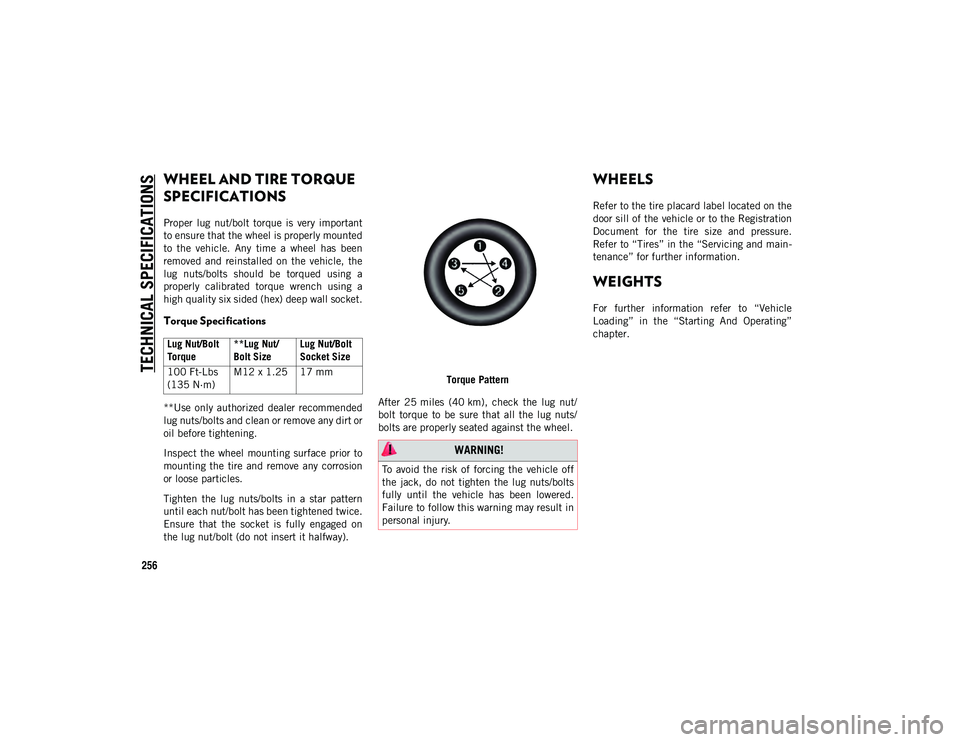
TECHNICAL SPECIFICATIONS
256
WHEEL AND TIRE TORQUE
SPECIFICATIONS
Proper lug nut/bolt torque is very important
to ensure that the wheel is properly mounted
to the vehicle. Any time a wheel has been
removed and reinstalled on the vehicle, the
lug nuts/bolts should be torqued using a
properly calibrated torque wrench using a
high quality six sided (hex) deep wall socket.
Torque Specifications
**Use only authorized dealer recommended
lug nuts/bolts and clean or remove any dirt or
oil before tightening.
Inspect the wheel mounting surface prior to
mounting the tire and remove any corrosion
or loose particles.
Tighten the lug nuts/bolts in a star pattern
until each nut/bolt has been tightened twice.
Ensure that the socket is fully engaged on
the lug nut/bolt (do not insert it halfway).Torque Pattern
After 25 miles (40 km), check the lug nut/
bolt torque to be sure that all the lug nuts/
bolts are properly seated against the wheel.
WHEELS
Refer to the tire placard label located on the
door sill of the vehicle or to the Registration
Document for the tire size and pressure.
Refer to “Tires” in the “Servicing and main -
tenance” for further information.
WEIGHTS
For further information refer to “Vehicle
Loading” in the “Starting And Operating”
chapter.
Lug Nut/Bolt
Torque **Lug Nut/
Bolt SizeLug Nut/Bolt
Socket Size
100 Ft-Lbs
(135 N·m) M12 x 1.25 17 mm
WARNING!
To avoid the risk of forcing the vehicle off
the jack, do not tighten the lug nuts/bolts
fully until the vehicle has been lowered.
Failure to follow this warning may result in
personal injury.
2020_JEEP_CHEROKEE_UG_RHD_UK.book Page 256